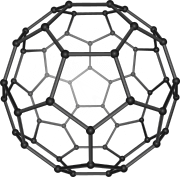The nanomaterials field includes subfields which develop or study materials having unique properties arising from their nanoscale dimensions.[35]
- Interface and colloid science has given rise to many materials which may be useful in nanotechnology, such as carbon nanotubes and other fullerenes, and various nanoparticles and nanorods. Nanomaterials with fast ion transport are related also to nanoionics and nanoelectronics.
- Nanoscale materials can also be used for bulk applications; most present commercial applications of nanotechnology are of this flavor.
- Progress has been made in using these materials for medical applications; see Nanomedicine.
- Nanoscale materials such as nanopillars are sometimes used in solar cells which combats the cost of traditional silicon solar cells.
- Development of applications incorporating semiconductor nanoparticles to be used in the next generation of products, such as display technology, lighting, solar cells and biological imaging; see quantum dots.
- Recent application of nanomaterials include a range of biomedical applications, such as tissue engineering, drug delivery, antibacterials and biosensors.[36][37][38][39][40]










